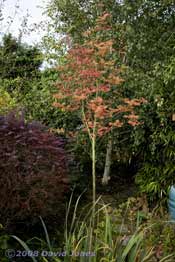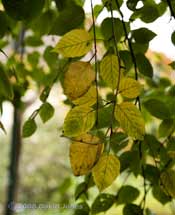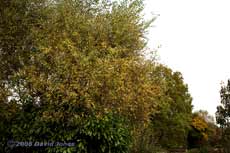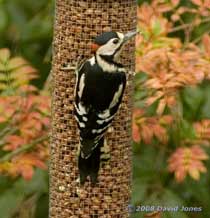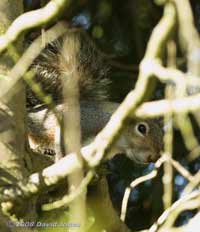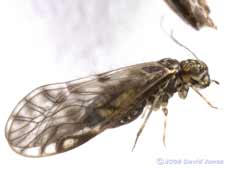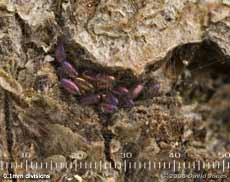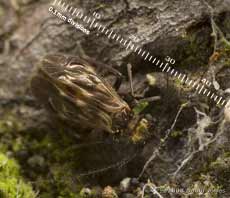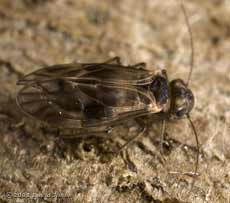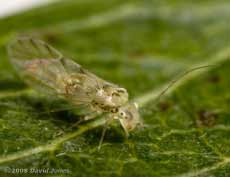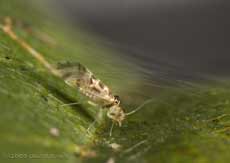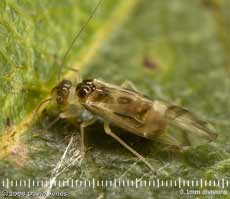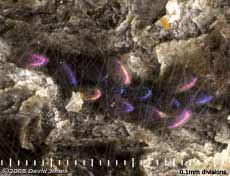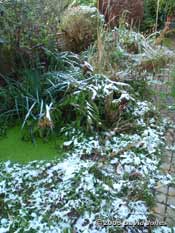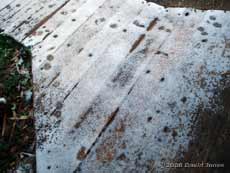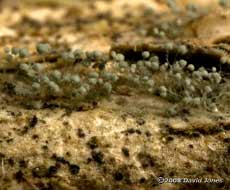Go to the last entry on this page .....Go to previous entry2 October - Back home safely after an enjoyable time in Cornwall with the sort of weather we should have had in the Summer! The garden is in need of attention and will probably keep me busy for a few days once we have checked, cleaned and put away all our caravanning bits ready for the winter. At the bottom of the garden the paper brickettes we made before the holiday seem to have dried well in our absence. The first ones may well be tested in the near future, and we brought home a pile of newspapers ready to make the next batch!
6 October - I'm taking a bit of time to recover from that relaxing holiday, so that I've done very little since our return. The weather has been largely gloomy although there hasn't been the heavy rain that was expected. Thanks to Tim Norriss for more help with moth (and Dragonfly) ID's in y September diaries. It doesn't take long for the birds to return once the feeders are refilled. At least a dozen Goldfinches can be seen there frequently during the day, and today I've seen Blue, Great and Coal Tits here. 'Our' House Sparrows are definitely not as numerous as in the past, but there must be a couple of dozen hanging about the Hawthorn and the feeders. Yesterday I caught a brief look of a warbler in the Hawthorn, probably either a Willow Warbler or a Chiffchaff - I shall have to listen more carefully to bird calls in the garden to help decide which it is. I got another 15 brickettes made this morning. We've used our log burner couple of times over the last few days and had the opportunity to try out a couple of the first brickettes made. I'm encouraged - each one burned for over an hour.
14 October - Since our return from Cornwall I've been having another one of those periods when doing much of anything has been too much effort. The weariness is easing up but I'm still not able to keep going past lunchtime. Over the last few mornings I have been able to get some overdue tidying work done in the garden. I haven't used a strimmer for the last ten years at least, but on the weekend I dug mine out for the back of the shed, put a new cable on it and used it to trim areas around the path. I hate strimmers, but it did made life easier on that occasion.
The garden has a touch of Autumn colour provided by the Rowan, although behind it the Birch shows only a few signs of changing leaf colour,
the most drastic changes happening to leaves on lower branches within the overall leaf canopy.
In contrast, my neighbour's native Birch has changed quite a bit over the last few days. In this picture you can also see some of the trees that line the border of the Brickfields Country Park.
Down at ground level plants are continuing to grow and there are still flowers on Cosmos plants, White Dead Nettles, Red Campions, Water Mint, Herb Roberts, a Ragwort plant, and a Ragged Robin plant. There are still Bumble (Carder) Bees visiting the White Dead Nettles, and there are wasps about, having been absent for most of the year so far. I have found very few insects while trimming the shrubs in the garden - just a couple of Mirid Bugs (possibly Liocoris tripustulatus - sorry, but no picture), and a common Green Shieldbug. I have seen just one ladybird over the last week, and that was a Harlequin. I had expected to see quite a few of this species this year, but like all the other species they have been few and far between. Down on the Birch I can only see a single Orange Ladybird pupa at the moment, with no sign of wither larvae or adults, which is very disappointing at a time when the leaves are covered with mildew. Yesterday morning, while I was making some more brickettes I was drawn to the bottom of the garden by a puzzling noise. I couldn't decide whether or not it was a bird in trouble in the conifers beyond the bottom of the garden, but I couldn't see the source of the sounds. Coincidently, there was also a male Blackbird that was obviously distressed about something. However the sound then stopped and nothing appeared, so I was left puzzled. Then, this morning the sounds started again. This time I dashed into the house, grabbed my mini-disc recorder, and managed to capture this sequence (file size - 419KB). This time the culprit made an appearance (and, of course I'm holding a microphone and not a camera! - it was a Grey Squirrel, which carried on making the calls for a couple of minutes as it looked down at me. While the Squirrel is a quite frequent visitor to the garden I'd never hear it making these calls until yesterday.
15 October - One of those miserable, grey days with occasional drizzle,
but a bit of brightness turned up in the form of this male Great Spotted woodpecker, (Last year it turned up on 13/14 Oct). It only stayed for a few minutes, but at least it now knows that the peanut feeder has been refilled.
I have neither seen nor heard the squirrel today, but I have now produced an audio CD with yesterday's recording expanded to last for an hour. When I know that the squirrel is about the idea is to play the CD and watch the squirrel's reaction to it. I tested the recording on birds coming to the feeders. So far the squawks have been ignored by the Sparrows, Goldfinches, Great and Blue Tits. The sequence can now be accessed via the Sounds page of the website. I forgot to mention yesterday that we continue to get regular evening visits by at least one hedgehog. I put out some suitable food and there is usually a hedgehog feeding by 8pm.
18 October - We have just had a couple of very pleasant sunny days. While I did no gardening, I did make some more brickettes which means that despite having been burnt we have now built up a stock of over a hundred, with more paper being soaked! The squirrel has performed around noon for the last two days, and today I managed to grab a couple of shots of it as it called. While it could just be reacting to a cat (although I have neither seen nor heard one during the call sequence) I wonder if it could be a territorial display. It flicks its tail up as it calls. I played the recording on both days. As soon as the play-back started the squirrel fell silent. Yesterday it appeared in the trees above me, looked down and then moved off towards the Brickfields Country Park. Today it could already see me when the CD started playing but reacted in the same way, moving off without any sign of panic .
I've just looked back in the diary and I see that I recorded the same species on 19 October last year. It is Philotarsus parviceps, a common species, although the Barkfly Recording Scheme website suggests that the species has usually disappeared from plants by mid-September (extreme date: 6 Oct) in the South.
20 October - A dull, overcast day - breezy, with some dampness in the air, although quite mild at 14.5C at noon. It may be wishful thinking, but I'm sure that for a few moments the clouds became a lighter shade of grey! First of all, a big 'thank you' to Nick in Brussels and Peggy in North Carolina (USA - home of the Grey Squirrel) who have identified that the squirrel call as one of alarm. Peggy tells me that she has more than half a dozen Grey Squirrels in her 1.5 acre yard and they often make this call, usually triggered by cats, but sometimes by her grandchildren! Back to the garden. Still not much being done at the moment, but last night I went down the bottom of the garden to collect some kindling from the log shelter. Needless to say, I took a torch and a magnifying lens, although I didn't need the latter to spot the subject of this first photograph. Since we came back from our holiday I've been making occasional checks for barkflies, both on the shrubs and trees in the garden, and also in the log pile after last Autumn's finds. At the beginning of the month I had difficulty finding any. However, over the last few days I've been finding more and more.
It was in fact the bluish light of the torch reflecting off the iridescent casings of a group of barkfly eggs that had been laid in a crack in the bark, and covered by an open mesh of silk. Each egg measures around 0.4mm in length, and I can count seventeen of them.
It's an Epicaecilius pilipennis, a species I first recorded here right at the beginning of January. It will be great if I can show that the eggs are of this species. There are nymphs about and I much make sure that I photograph them as well. I need to get a suitable container so that I can isolate the log and then monitor the eggs to see what hatches. There appear to be quite a few of this species elsewhere on the logs.
On another log I also found a few examples of Peripsocus milleri. This is a nationally scarce species that I first found here in October last year, so I'm very pleased to find that they are still about. Hopefully I'll find more of these, as well as other species as I check the logs more thoroughly - watch out for more barkfly portraits over the next few days!
By the end of the afternoon it was raining so I wasn't able to use my camera out in the garden after dark. However, I did spend a while checking the logs in the log store and managed to find another batch of eggs like the ones above. These are deeper in a crack in the bark and will be more difficult to photograph. However, that log is now in 'isolation' in a container and I shall be monitoring the eggs.
Although I haven't included a scale in these pictures, the adults measure around 3mm in length (head to wing tip).
I also collected a larger, if equally pale barkfly from the hawthorn, and I hope to take some photographs of those tomorrow.
21 October - The weather yo-yo means that today is largely cloudless, although still with a cold breeze. This morning I had a chance to try out my squirrel recording when the real think came to the bird table. I had the loudspeaker out on the veranda, about six feet from the table. I started off with the volume low. The squirrel ignored it and carried on eating until the volume was increased to about three-quarters of full volume, when it adopted an alert posture at the edge of the table. As I decreased the volume again it resumed eating. Next, I gradually raised to volume to maximum. As soon as that happened the squirrel became very agitated, paused for a moment at the edge of the table and then left. It returned a few minutes after I stopped the play-back. Several minutes later It left in a hurry when I played the recording again at full volume. A couple of hours later, just before noon, I heard the squirrel itself calling from the line of conifers, although not directly behind our garden this time.
While I watched, it spent a while constructing itself a silk canopy across the 'valley' created about the central vein of a Hawthorn leaf. It then rested under the silk for the best part of an hour before becoming active again.
Measuring around 4mm in length it had somewhat paler wing markings than other specimens of the same species that I have found here in the past.
23 October - A rather cloudy, windy day with a bit of dampness at times in the evening.
Again, the only species I can see on the log is Epicaecilius pilipennis, so it seems increasingly likely that the eggs belong to this species.
We have neither seen or heard the squirrel over the last two days. In contrast, the hedgehogs are here by 8pm each night.
29 October - We had our first taste of Winter early this morning. Sheila looked out at some unearthly hour (because she heard something being moved on our veranda), and noticed that there was a thin covering of snow.
By the time I peered out at around 7.30am it was clear that much of the snow had melted, especially on the concrete and stone surfaces which will have retained some heat over night after yesterday's sunshine.
In contrast to those surfaces, an exposed extension of out veranda decking remained covered with a thin, almost uniform layer of snow. Signs of what are probably cat prints, along with the hedgehog food dish having been moved, may explain the noises that Sheila heard. Despite hazy sunshine all day, areas of snow remained, and there are still a few bits on the decking tonight.
Although I've done precious little in the garden since the last entry, I have made daily checks on the log store and its population of barkflies. I have now found seven groups of those colourful eggs. During my searches I have found quite a few E. pilipennis, whish have out-numbered by at least 10:1 the seven P. milleri, six examples of L. variegata and just a few E. petersi. The barkflies had been very active after dark each evening. However, last night it was colder, around 4C amongst the logs at 9pm. There were still barkflies moving about, although they were nowhere as active as previously.
While my cameras have remained largely unused these last few days, I did record an example of a fungus (or mildew?) growing on a piece of Ivy wood that I kept to use as kindling after I cropped the Ivy tree earlier in the year. The tiny fruiting bodies resemble fluffy green pom-poms measuring less than 0.1mm across. Click on images to see larger versions |
|
